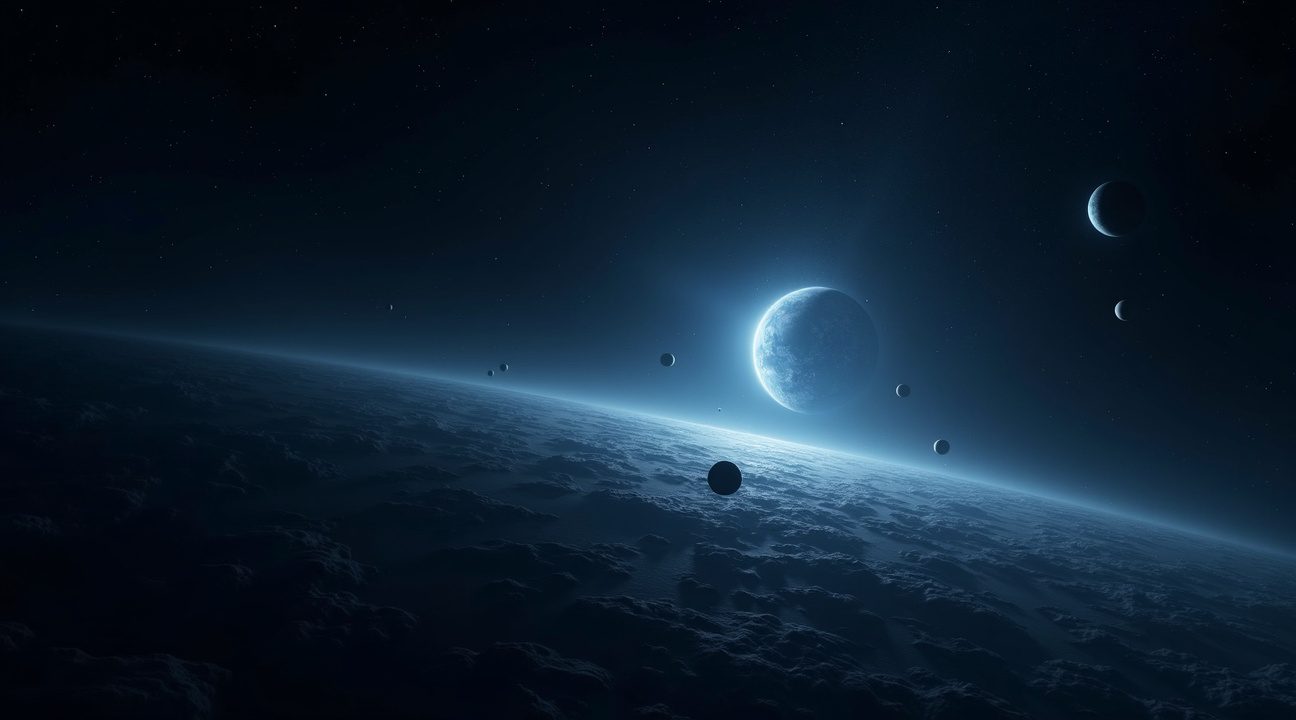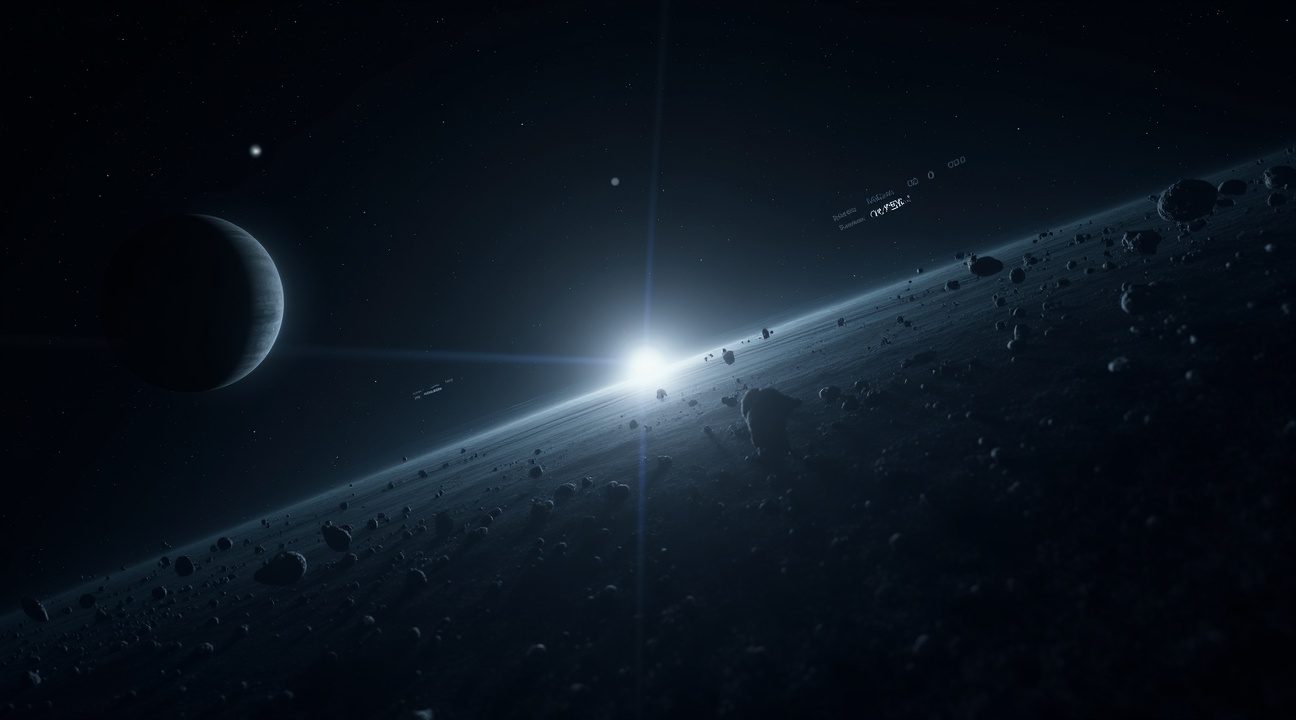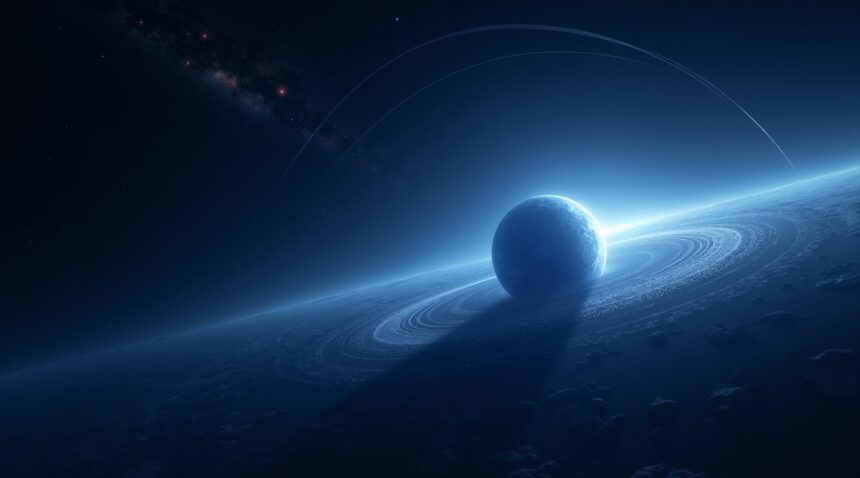Scientists have recently uncovered a potential distant planet in our solar system through the analysis of archival satellite data, although its unusual orbit raises new questions about Planet Nine’s predicted characteristics.
Key Takeaways
- Promising Candidate Identified: In May 2025, researchers pinpointed a “good candidate” for Planet Nine using decades-old data from Japanese and NASA satellites, though the object’s orbit is unexpectedly tilted compared to earlier theoretical models.
- Theoretical Characteristics: Planet Nine is predicted to be a super-Earth or Neptune-sized body with roughly 5–10 times Earth’s mass, orbiting about 290 astronomical units from the Sun.
- Challenges from New Discoveries: The recent identification of additional dwarf planets and sednoids has led some experts to question the Planet Nine theory, proposing that the observed orbital groupings might reflect observational bias instead of gravitational effects.
- Scientific Debate Persists: Astronomers continue to debate the validity of Planet Nine, considering various explanations including gravitational effects from multiple smaller bodies, statistical chance, or even alternative models of gravity.
- Future Observations: The upcoming Vera C. Rubin Observatory offers the most promising opportunity to either confirm or refute Planet Nine’s existence, with detailed sky surveys slated to unfold over the coming decade.
Mysterious Planet Candidate Spotted in Decades-Old Sky Survey Data
I find myself examining one of the most intriguing astronomical discoveries of our time. In May 2025, Phan et al. made headlines when they identified what they described as a “good candidate” for a distant planet lurking in our solar system’s outer reaches. This discovery emerged from careful analysis of historic satellite data spanning multiple space agencies and decades of observation.
The research team combed through archives from Japan’s AKARI satellite, NASA’s IRAS and WISE missions, along with data from Japan’s Subaru telescope. Each of these instruments had been scanning different portions of the sky over the years, unknowingly capturing glimpses of what might be our solar system’s most elusive member. When researchers combined these datasets, they found an object whose characteristics align remarkably well with predictions for a large, remote planet.
Orbital Mysteries Challenge Initial Predictions
However, this candidate presents a significant puzzle that has astronomers scratching their heads. The object’s orbit appears to be highly tilted compared to what scientists originally predicted for the hypothetical Planet Nine. This unexpected orbital inclination raises serious questions about whether this candidate truly represents the long-sought ninth planet or something else entirely.
The tilted orbit doesn’t necessarily disqualify the object, but it does complicate the narrative. Scientists had developed specific models for where and how Planet Nine should move through space, and this candidate doesn’t behave exactly as expected. Such discoveries remind us that space continues to surprise researchers, much like recent findings about building blocks in Saturn’s moon or deep ocean discoveries that challenge our understanding of extreme environments.
Despite the excitement surrounding this candidate, significant challenges remain. No object has been tracked long enough to establish a definitive orbit or measure its physical characteristics with certainty. The time scales involved in monitoring such distant objects require patience that stretches across years or even decades.
As of July 2025, the astronomical community maintains a cautious stance. While several compelling candidates have emerged from intensive searches, none have achieved the status of an undisputed or officially confirmed ninth planet. Planet Nine remains firmly in the category of a hypothetical giant planet—a tantalizing possibility rather than confirmed reality.
The discovery process mirrors other scientific breakthroughs that require extensive verification, similar to how researchers approach complex neurological phenomena. Each new piece of evidence brings us closer to understanding whether our solar system truly harbors this mysterious ninth world, but confirmation requires more time and additional observations.
The Hunt for Planet Nine: From Theory to Active Search
The scientific journey to find Planet Nine began in earnest when I consider the groundbreaking work of Caltech astronomers Konstantin Batygin and Michael Brown in 2016. These researchers didn’t just stumble upon this possibility—they carefully analyzed unusual orbital patterns in extreme trans-Neptunian objects (TNOs) that exist in the frigid outer reaches beyond Neptune. Their observations revealed something extraordinary: these distant objects appeared to be gravitationally influenced by an unseen massive body.
What Scientists Believe They’re Looking For
Planet Nine isn’t expected to be just another small rocky world like the planets closer to the Sun. Current models suggest this hypothetical planet could be a super-Earth or Neptune-sized object with a mass 5–10 times greater than Earth. This massive scale would explain its considerable gravitational influence on distant TNOs, similar to how Saturn’s moons experience gravitational effects from their giant host planet.
Distance calculations have undergone significant refinement since the initial proposal. Early estimates placed Planet Nine between 400–800 astronomical units (AU) from the Sun, but updated 2025 models have adjusted this range to approximately 290 ± 30 AU. To put this vast distance in perspective, one AU equals about 150 million kilometers—the average distance from Earth to the Sun. At 290 AU, Planet Nine would orbit nearly 300 times farther from the Sun than Earth does.
Theories Behind Planet Nine’s Origins
Scientists have developed several compelling theories about how Planet Nine might have formed or arrived in its current location. Below are the main hypotheses:
- Planetary Ejection: The most widely accepted hypothesis suggests that Jupiter ejected the planet from the early solar system through gravitational interactions. During the solar system’s chaotic early period, massive planets like Jupiter could have scattered smaller worlds into distant orbits or expelled them entirely.
- In-Situ Formation: Another possibility involves Planet Nine forming in place on its current wide orbit. This scenario would require specific conditions during the solar system’s formation that allowed a large planet to coalesce at such an enormous distance from the Sun.
- Captured Rogue Planet: Some researchers explore the intriguing possibility that Planet Nine originated as a rogue planet from another star system, eventually captured by our Sun’s gravitational field.
The search continues to intensify as technology improves and new surveys come online. Advanced telescopes and computational models help astronomers narrow down search areas and refine predictions about Planet Nine’s characteristics. Each discovery of new TNOs provides additional data points that either support or challenge the Planet Nine hypothesis.
This ongoing investigation represents one of astronomy’s most exciting active searches, combining observational astronomy with theoretical modeling to potentially reshape our understanding of the solar system’s architecture. The unusual orbital patterns that first sparked interest continue to accumulate, and researchers like those studying deep ocean discoveries know that persistent searching often leads to remarkable findings.
Whether Planet Nine exists remains to be definitively proven, but the methodical approach taken by Batygin, Brown, and their colleagues demonstrates how modern astronomy tackles complex questions about our cosmic neighborhood. Their work has already revolutionized how scientists think about the outer solar system’s structure and the gravitational forces that shape planetary orbits billions of miles from the Sun.

New Discoveries Challenge the Planet Nine Theory
Recent astronomical findings are casting doubt on the existence of the hypothetical Planet Nine. The discovery of new dwarf planets and sednoids has complicated scientists’ understanding of distant object behavior in our solar system. I find these developments particularly fascinating because they’re reshaping decades of theoretical work.
Challenging Evidence from New Discoveries
The 2023 discovery of “Ammonite” (2023 KQ14) represents one of several findings that question the Planet Nine hypothesis. These newly identified objects don’t conform to the expected orbital clustering patterns that originally led scientists to propose a massive ninth planet. Instead of supporting the theory, these discoveries suggest alternative explanations for the unusual behaviors observed in Trans-Neptunian Objects (TNOs).
Scientists initially proposed Planet Nine to explain why certain distant objects appeared to cluster in similar orbital patterns. However, growing evidence indicates that these groupings might result from observational bias rather than gravitational influence from an unseen giant planet. This shift in understanding mirrors other astronomical revelations, much like recent discoveries about perception that challenge our assumptions about familiar phenomena.
Scientific Scrutiny and Growing Skepticism
Despite extensive follow-up optical and infrared observations, no candidate has met the strict criteria required for official planetary confirmation. The scientific community maintains rigorous standards for validating such extraordinary claims, and current evidence falls short of these requirements.
This skepticism reflects the methodical approach astronomers take when evaluating potential discoveries. Just as researchers carefully examine deep ocean findings, space scientists demand comprehensive verification before accepting new planetary bodies. The absence of definitive proof has led many astronomers to question whether Planet Nine exists at all.
The debate continues as new observational data emerges. Some researchers argue that improved detection methods and longer observation periods might eventually reveal Planet Nine’s location. Others contend that alternative explanations, such as modified gravity theories or statistical coincidences, better account for the observed orbital anomalies.
Current evidence suggests that what scientists initially interpreted as clustering might actually represent normal variation in TNO orbits. This possibility undermines the primary justification for Planet Nine’s existence, leaving the hypothesis increasingly unsupported by empirical data.
What a Ninth Planet Would Mean for Our Solar System
The confirmation of Planet Nine would fundamentally transform how I understand the architecture of our solar system. This discovery wouldn’t just add another celestial body to our cosmic neighborhood — it would reshape decades of scientific models about planetary formation and gravitational dynamics throughout the outer regions of our solar system.
Revolutionary Impact on Solar System Understanding
Finding Planet Nine would provide a concrete explanation for the mysterious orbital clustering of trans-Neptunian objects that has puzzled astronomers for years. These distant icy bodies currently exhibit unusual orbital patterns that suggest the gravitational influence of a massive, unseen object. I’ve observed how NASA scientists find essential discoveries that challenge our assumptions about planetary systems, and Planet Nine represents another paradigm shift.
The gravitational signature of this hypothetical planet could explain why certain Kuiper Belt objects follow such eccentric, elongated orbits. Current models struggle to account for these patterns without invoking the presence of a substantial planetary mass lurking in the outer darkness of our solar system.
Restoring the Nine-Planet Count
Since the International Astronomical Union reclassified Pluto as a dwarf planet in 2006, our solar system officially contains eight planets. Many scientists believe that proving Planet Nine’s existence would restore the traditional nine-planet count, though under much clearer scientific criteria.
The key distinction lies in planetary characteristics that separate true planets from dwarf planets:
- Ability to clear its orbital path of debris and smaller objects
- Sufficient mass to maintain a roughly spherical shape through gravitational forces
- Direct orbit around the Sun rather than another celestial body
- Dominant gravitational influence within its orbital zone
Planet Nine would likely satisfy all these requirements, unlike Pluto, which shares its orbital space with numerous other objects in the Kuiper Belt. This massive body would possess the gravitational dominance necessary to qualify as a legitimate planet under current astronomical definitions.
The search for Planet Nine demands sophisticated detection methods and cutting-edge technology. Deep sky surveys must scan vast regions of space where this elusive world might hide. These surveys require extraordinary sensitivity to detect an object that reflects minimal sunlight at such extreme distances from our star.
The upcoming Vera C. Rubin Observatory represents a game-changing tool in this cosmic hunt. This facility will conduct comprehensive surveys of the southern sky, potentially capturing the faint light signature that would reveal Planet Nine’s location. I expect this observatory’s advanced capabilities will either confirm or definitively rule out the existence of this mysterious world within the next decade.
Ground-based telescopes face significant challenges when searching for Planet Nine. The object’s incredible distance means it would appear as an extremely faint point of light, easily confused with background stars or distant galaxies. Researchers must carefully analyze years of observational data to detect the subtle motion that would distinguish a planet from stationary celestial objects.
The discovery timeline depends largely on Planet Nine’s current position in its hypothetical orbit. If positioned in dense star fields near the galactic plane, detection becomes exponentially more difficult. Conversely, if located in less crowded regions of sky, modern surveys might spot it relatively quickly.
Advanced computer modeling helps narrow the search parameters by predicting where Planet Nine might currently reside based on its gravitational effects on known objects. These models continuously refine their predictions as astronomers gather more data about trans-Neptunian object orbits and their unusual clustering patterns.
The confirmation of Planet Nine would validate theoretical models that predict its existence while opening new questions about planetary formation in the outer solar system. Such researchers find that major discoveries often lead to even more intriguing possibilities for exploration and understanding.
https://www.youtube.com/watch?v=UD9HcokaQYw
The Scientific Debate: Multiple Theories Compete
I’ve observed significant division within the astronomical community regarding Planet Nine’s existence. While some researchers champion the hidden planet hypothesis, others remain deeply skeptical about the evidence presented so far. This disagreement stems from the challenge of interpreting complex orbital patterns observed in trans-Neptunian objects (TNOs) located in the outer reaches of our solar system.
Competing Explanations for Orbital Clustering
The scientific community actively debates several theories that could explain the unusual clustering of distant objects’ orbits. Each explanation carries its own merits and potential weaknesses:
- An undiscovered super-Earth-sized planet exerting gravitational influence from the outer solar system
- Collective gravitational effects from numerous smaller objects creating apparent clustering patterns
- Observational biases that make certain orbital configurations more likely to be detected
- Statistical coincidences that may not represent actual physical phenomena
- Alternative gravitational models that don’t require a massive ninth planet
I find it fascinating how these different theories reflect broader questions about detection methods and data interpretation in astronomy. Some researchers point to discoveries in other fields as examples of how initial observations can lead to unexpected conclusions.
The Challenge of Definitive Proof
Astronomers face substantial obstacles in resolving this debate conclusively. Current technology limits direct observation of objects at Planet Nine’s proposed distance, making indirect evidence the primary tool for investigation. The debate mirrors challenges scientists encounter when studying other remote phenomena, such as those found in unexplored environments closer to home.
Many researchers emphasize that definitive proof requires either direct imaging of a candidate planet or comprehensive long-term tracking of its gravitational effects. The timeline for such confirmation could span decades, particularly given the extremely long orbital periods involved. Objects at these distances take hundreds or thousands of years to complete single orbits around the Sun.
I notice that skeptics often point to previous instances where apparent patterns in astronomical data later proved to be artifacts of observation techniques or statistical flukes. They argue that extraordinary claims require extraordinary evidence, particularly when proposing the existence of a major planetary body that has evaded detection for centuries.
Alternative explanations gain traction among researchers who question whether current data truly supports a ninth planet. Some propose that the clustering effect results from selection biases in how astronomers search for and catalog distant objects. Others suggest that random distributions of small bodies could create apparent patterns without requiring a massive gravitational shepherd.
The debate extends beyond simple existence questions to fundamental issues about solar system formation and evolution. If Planet Nine exists, it would challenge current models of how planets form and migrate during the early stages of stellar system development. Conversely, if alternative explanations prove correct, they might reveal new insights about the distribution of matter in the outer solar system.
Recent technological advances in telescope capabilities and data processing methods continue to add new observations to this ongoing discussion. Projects like the Vera Rubin Observatory promise to dramatically increase the number of known TNOs, potentially providing the statistical clarity needed to resolve competing theories. Similarly, advances in space exploration, such as those demonstrated in recent lunar missions, showcase humanity’s growing capacity to explore distant environments.
I observe that this scientific uncertainty reflects the healthy skepticism essential to rigorous research. Rather than rushing to conclusions, the astronomical community continues gathering evidence and refining theoretical models. This methodical approach ensures that any eventual confirmation or refutation of Planet Nine will rest on solid observational foundations rather than premature speculation.
The ongoing debate demonstrates how frontier science operates, where competing hypotheses coexist until sufficient evidence emerges to support definitive conclusions. Whether Planet Nine ultimately joins the confirmed roster of solar system planets or becomes a cautionary tale about pattern recognition in sparse data, this scientific process exemplifies astronomy’s commitment to evidence-based discovery.

Future Searches and What Comes Next
The astronomical community has turned its attention to cutting-edge observatories that promise to deliver the crucial evidence needed to settle the Planet Nine debate once and for all. The Vera C. Rubin Observatory stands as the most promising tool in this quest, equipped with advanced imaging capabilities that will generate critical datasets to address remaining questions about this potential distant world.
Advanced Observatory Technology
I expect the Vera C. Rubin Observatory to revolutionize our search capabilities through its unprecedented sky survey capabilities. This powerful facility will systematically scan vast regions of space, capturing detailed images that could reveal the elusive ninth planet’s location. Current infrared and optical surveys continue their vigilant monitoring of candidate objects, with researchers hoping to verify orbital patterns that would confirm planetary status.
The Verification Process
Establishing whether any candidate truly qualifies as a planet requires extensive tracking of its movement through infrared imagery over extended periods. Scientists must observe these objects across multiple observation cycles to map their precise orbital characteristics. This process demands patience, as planetary discoveries require confirmation through repeated observations spanning years.
The verification timeline reflects the cautious approach that astronomers maintain when evaluating such significant discoveries. Unlike previous findings where scientists think they’ve discovered various phenomena, planetary confirmations demand irrefutable evidence. Researchers continue monitoring multiple candidate objects while simultaneously developing more sophisticated detection methods.
Advanced computational models now guide search efforts, helping astronomers predict where Planet Nine might appear in future observations. These models factor in gravitational influences and orbital mechanics to narrow search parameters. Teams coordinate their efforts across multiple observatories, sharing data to accelerate the discovery process.
Until definitive tracking data emerges from these ongoing surveys, scientists maintain their cautious stance regarding Planet Nine’s existence. The astronomical community understands that claiming a new planetary discovery requires extraordinary evidence, particularly given the historical context of previous planetary reclassifications. Future observations from the Vera C. Rubin Observatory and other advanced facilities will likely provide the final answer to whether our solar system truly contains a ninth planet.

Sources:
Space.com – Astronomers discover cosmic fossil on edge of solar system — could it be Planet 9?
Live Science – Planet Nine? Astronomers spot potential ninth planet far beyond Neptune
Live Science – Astronomers discover new dwarf planet ‘Ammonite,’ and it could upend the existence of Planet Nine
Space.com – Planet Nine evidence grows with sky surveys 23 years apart
Wikipedia – Planet Nine
Phys.org – Mysterious planet offers clues about the edges of the Solar System
NASA Science – Hypothetical Planet X


